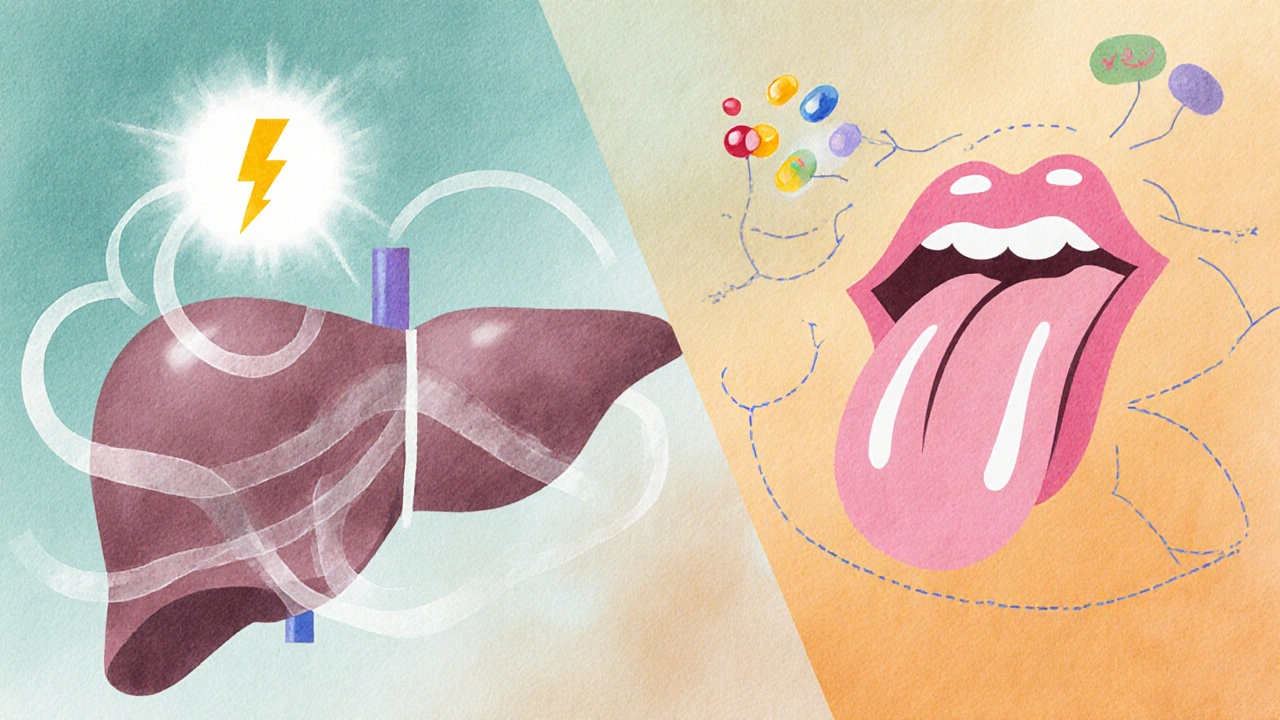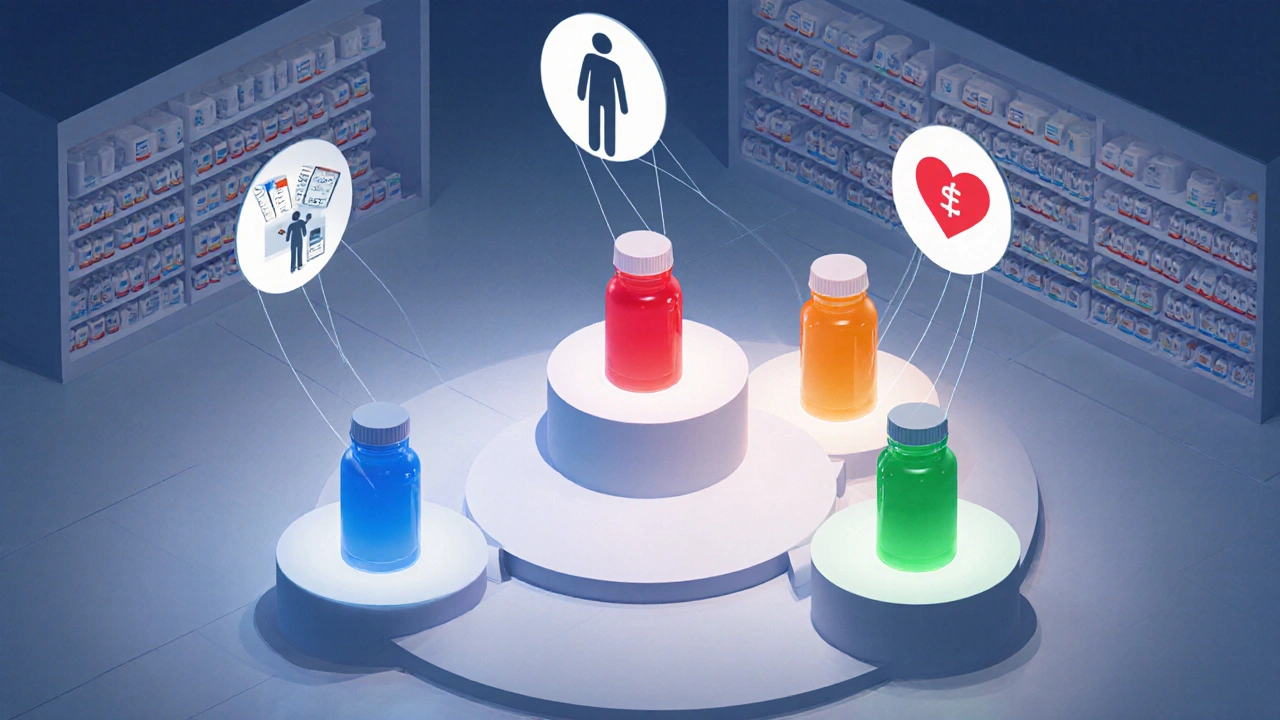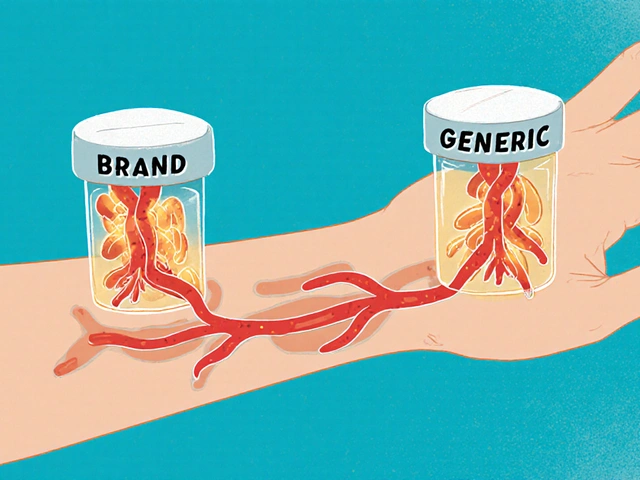Oral Antifungal Selection Guide
Griseofulvin
Dermatophytes Only Long Course Liver Monitoring
Mechanism: Disrupts microtubule assembly
Duration: 4-12 weeks
Success Rate: 70-80%
Terbinafine
Fast Acting Short Course Taste Loss Risk
Mechanism: Inhibits ergosterol synthesis
Duration: 2-6 weeks
Success Rate: 85-95%
Itraconazole
Broad Spectrum Pulse Therapy Hepatotoxicity Risk
Mechanism: Blocks lanosterol 14α-demethylase
Duration: 1-4 weeks
Success Rate: 80-90%
Fluconazole
Water Soluble Systemic Use QT Prolongation Risk
Mechanism: Blocks lanosterol 14α-demethylase
Duration: 2-4 weeks
Success Rate: 75-85%
Side Effect Comparison
| Drug | Common Side Effects | Special Considerations |
|---|---|---|
| Griseofulvin | Liver enzyme elevation, headache, GI upset | Monitor liver enzymes, long treatment course |
| Terbinafine | Taste loss, GI upset, rash | Mild interactions, may increase warfarin levels |
| Itraconazole | Hepatotoxicity, heart failure risk, drug interactions | Strong CYP3A4 inhibitor, monitor liver enzymes |
| Fluconazole | Hepatic dysfunction, QT prolongation | Can interact with several drugs, monitor ECG if needed |
Decision Factors
- Infection Type: Dermatophyte infections typically respond well to Griseofulvin, but faster clearance favors Terbinafine.
- Patient Age & Liver Health: Children and those with liver disease may benefit from Griseofulvin or Terbinafine instead of Itraconazole or Fluconazole.
- Drug Interactions: Itraconazole and Fluconazole are potent inhibitors of liver enzymes and may interact with many medications.
- Cost & Availability: Griseofulvin is inexpensive and widely available, whereas newer agents may be more costly but offer convenience.
Key Takeaways
- Griseofulvin works by disrupting fungal cell division and is best for long‑term skin infections.
- Terbinafine, itraconazole and fluconazole act faster and often require shorter courses.
- Side‑effect profiles differ: Griseofulvin can cause liver issues, while terbinafine may trigger taste loss.
- Drug interactions are a major factor - itraconazole and fluconazole inhibit many enzymes.
- Choosing the right drug depends on infection type, patient age, liver health and cost considerations.
When a doctor prescribes an oral antifungal, the decision isn’t always straightforward. Griseofulvin has been the go‑to for dermatophyte infections for decades, but newer agents promise quicker results and fewer side effects. This guide breaks down how Griseofulvin stacks up against the most common alternatives, so you can understand which option fits a specific case.
What Is Griseofulvin?
Griseofulvin is a synthetic derivative of a fungus‑produced compound that interferes with fungal mitosis. It belongs to the class of antifungal agents targeting dermatophytes. First approved by the FDA in 1959, it is marketed worldwide under brand names like Grifulvin V and Antizol. Typical adult dosing is 500-1000mg daily, taken with meals for 4-12weeks depending on the infection’s severity.
Key attributes:
- Mechanism: Inhibits microtubule formation, stopping fungal cell division.
- Spectrum: Primarily dermatophytes (e.g., Trichophyton, Microsporum).
- Success rate: Around 70-80% clinical cure when taken as prescribed.
- Adverse effects: Liver enzyme elevation, headache, gastrointestinal upset, and rare photosensitivity.

Top Oral Alternatives
Newer antifungals have entered the market, each with distinct benefits and drawbacks. Below are the most frequently prescribed alternatives.
Terbinafine
Terbinafine is an allylamine that blocks the synthesis of ergosterol, a critical component of fungal cell membranes. It is highly effective against dermatophytes and some yeasts. The usual dose is 250mg once daily for 2-6weeks.
Itraconazole
Itraconazole, a triazole, inhibits the cytochromeP450‑dependent enzyme lanosterol14α‑demethylase, halting ergosterol production. It covers a broader spectrum, including molds and some Candida species. Dosing ranges from 200mg twice daily (pulse therapy) to 400mg once daily for 1-4weeks.
Fluconazole
Fluconazole, another triazole, also targets lanosterol14α‑demethylase but is more water‑soluble, making it useful for systemic infections. Typical dosing for skin infections is 150‑200mg once daily for 2-4weeks.
Ketoconazole
Ketoconazole was once a first‑line oral agent but is now limited due to hepatotoxicity concerns. When used, the dose is 200mg twice daily for 2-4weeks, and liver function must be closely monitored.
Side‑by‑Side Comparison
| Drug | Mechanism | Spectrum | Typical Dose & Duration | Success Rate | Common Side Effects |
|---|---|---|---|---|---|
| Griseofulvin | Disrupts microtubule assembly | Dermatophytes only | 500‑1000mg daily, 4‑12weeks | 70‑80% | Liver enzyme rise, headache, GI upset |
| Terbinafine | Inhibits ergosterol synthesis | Dermatophytes, some yeasts | 250mg daily, 2‑6weeks | 85‑95% | Taste loss, GI upset, rash |
| Itraconazole | Blocks lanosterol14α‑demethylase | Broad: dermatophytes, molds, Candida | 200mg BID (pulse) or 400mg daily, 1‑4weeks | 80‑90% (varies by organism) | Hepatotoxicity, heart failure risk, drug interactions |
| Fluconazole | Inhibits lanosterol14α‑demethylase | Candida, Cryptococcus, some dermatophytes | 150‑200mg daily, 2‑4weeks | 75‑85% | Hepatic dysfunction, QT prolongation |
| Ketoconazole | Inhibits lanosterol14α‑demethylase | Dermatophytes, some yeasts | 200mg BID, 2‑4weeks | 70‑80% (when tolerated) | Severe hepatotoxicity, adrenal suppression |
How to Choose the Right Agent
Decision‑making hinges on three pillars: infection characteristics, patient factors, and drug safety.
- Infection type: If you’re dealing with a classic tinea corporis or tinea pedis caused by Trichophyton rubrum, Griseofulvin works but requires the longest treatment. For faster clearance, terbinafine is usually preferred.
- Patient age and liver health: Children under 12 often receive Griseofulvin because it has a proven safety record. Adults with pre‑existing liver disease should avoid itraconazole, fluconazole, and especially ketoconazole.
- Drug‑drug interactions: Itraconazole and fluconazole are strong CYP3A4 inhibitors, meaning they can raise levels of statins, certain anti‑arrhythmics, and immunosuppressants. Terbinafine has a milder interaction profile but can increase warfarin levels.
Cost also plays a role. Griseofulvin is generic and cheap in the UK, while newer agents may be pricier, although many are now available as generics too.

Practical Tips & Common Pitfalls
- Adherence: Griseofulvin’s long course can lead to missed doses. Set daily alarms or use a pill‑organizer.
- Monitoring: Baseline liver function tests (ALT, AST, bilirubin) are recommended for all agents except low‑dose terbinafine. Repeat after 2weeks if any abnormality appears.
- Food considerations: Griseofulvin absorption improves with fatty meals; terbinafine can be taken with or without food.
- Pregnancy: Griseofulvin is category B (UK: not contraindicated but use caution). Itraconazole and fluconazole are generally avoided in the first trimester.
- Resistance: Though rare for dermatophytes, prolonged sub‑therapeutic dosing can foster resistant strains. Ensure the prescribed dose matches the patient’s weight.
Frequently Asked Questions
Can I switch from Griseofulvin to Terbinafine mid‑treatment?
Switching is possible but should be done under medical supervision. A short overlap may be needed to avoid a gap in antifungal coverage, and liver tests should be repeated before starting terbinafine.
Why does Griseofulvin take so long to work?
Griseofulvin accumulates in keratin cells, which are then shed slowly as the skin renews. That natural turnover process can take weeks, explaining the extended treatment period.
Are there any over‑the‑counter options that work as well as Griseofulvin?
Topical agents like terbinafine 1% cream or clotrimazole can treat mild infections, but they don’t reach the deeper nail or hair follicles where oral therapy is needed. For extensive tinea corporis, an oral drug remains the most effective.
What should I do if I experience liver pain while on Griseofulvin?
Stop the medication immediately and contact your clinician. Liver enzymes should be checked, and alternative therapy (e.g., terbinafine) may be considered if liver toxicity is confirmed.
Is Griseofulvin effective for nail fungus?
Yes, but nail infections require longer courses-often 6-12months-because nails grow slowly. Newer agents like itraconazole pulse therapy are often preferred for better nail penetration and shorter overall treatment.
Next Steps & Troubleshooting
If you’ve started a course and see no improvement after 2weeks, consider these actions:
- Confirm the diagnosis with a skin scraping and fungal culture.
- Check adherence: missed doses are a common cause of failure.
- Review concomitant medications for enzyme‑inducing drugs that could lower drug levels (e.g., carbamazepine).
- Order repeat liver function tests to rule out subclinical toxicity.
- Discuss a switch to a faster‑acting agent like terbinafine or a broader‑spectrum triazole if the organism is resistant or the infection is atypical.
Remember, oral antifungals are powerful tools but require careful monitoring. By matching the infection profile with the right drug, you’ll maximise cure rates while keeping side effects in check.







Hannah Dawson
October 5, 2025 AT 16:43 PMLooking at the comparative table, it becomes obvious that Griseofulvin is a relic clinging to the past while its newer counterparts sprint ahead. The drug's prolonged course is a logistical nightmare for patients who already struggle with adherence. Moreover, the liver monitoring requirement adds an unnecessary layer of clinical burden. In short, prescribing Griseofulvin feels like an outdated convenience for physicians who prefer the status quo.
Julie Gray
October 19, 2025 AT 07:23 AMOne must consider the hidden machinations behind the promotion of newer antifungals; the pharmaceutical lobby exerts considerable influence over guideline committees. While the data appear robust, the possibility of selective reporting cannot be dismissed. Consequently, a cautious appraisal of each agent, free from corporate bias, is paramount.
Lisa Emilie Ness
November 1, 2025 AT 21:03 PMGriseofulvin requires long treatment.
Emily Wagner
November 15, 2025 AT 11:43 AMFrom a phenomenological standpoint, the kinetic profile of Griseofulvin embodies a temporal diffusion model that mirrors keratin turnover. In contrast, Terbinafine exhibits a rapid pharmacodynamic burst, akin to a quantum leap in therapeutic efficacy. This dichotomy underscores the necessity of aligning drug selection with the ontogeny of the infection.
Mark French
November 29, 2025 AT 02:23 AMI understand the concerns about liver monitoring; many patients are understandably anxious about potential side effects. Definately, it helps to schedule regular check‑ups and discuss any symptoms early. If you experience any unusual pain, please receieve medical advice promptly and consider alternative agents under guidance.
Daylon Knight
December 12, 2025 AT 17:03 PMSure, let’s all jump on the hype train for the newest pill and pretend the old one is evil – because economics is never a factor in medicine really.